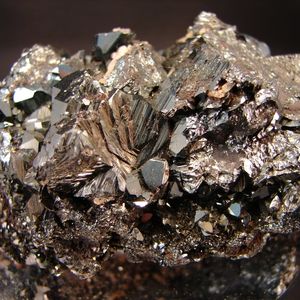The Many Magical Types of Hematite
Blood. That was the picture that came to mind when the ancients first glimpsed sight of the Hematite stone. Deep, vermillion red. Similar to the crimson flush that flows through our bodies that proves that we are alive.
It is what inspired the name. Haima. The ancient Greek word for blood, which became Haematite and more popularly Hematite. The association with our life-sustaining scarlet flow informs its magical and spiritual use.
For example, a midwife might employ Hematite to protect a laboring mother from bleeding out. Similarly, it has been used in yonder times to keep warriors from exsanguinating on the battlefield.
But not all Hematite looks like blood. For example, specularite glitters and twinkles like the night sky. Martite is a form of Hematite that shimmers with its mirror-like facets and looks suspiciously similar to magnetite.
Consider Iron Rose Hematite that visually stuns as it appears like roses crafted from metal. And Kidney Ore Hematite does its part to mimic the all-essential organ that bears its name – size, shape, and all.
Mother Nature is nothing if not creative. The same stone can take on many distinctly beautiful forms that evoke different emotions, showing her range.
What is Specularite?
To look upon Specular Hematite is like looking up into the night sky at the endless sea of stars. It sparkles luminously with glimmering, burnished flecks contrasted against an inky backdrop. These tiny speckles are little bits of Hematite and mica dispersed throughout the stone.
The many types of Hematite tend to resonate reliably with the Root Chakra as a standard. However, just one look at the brilliant spectacle of Specularite, and you might be able to intuit why it has the particular distinction of echoing with both the Root and Crown Chakras.
The very appearance of Specularite looks as if glimpsing a vision of the heavens. It is a befitting medium to enable your Crown Chakra to align with the majesty of the ethereal realm. The sparkles, like the stars, prime your mind for meditation on higher things and higher realms.
From Sweden to Brasil, Canada to Switzerland, England, and even the United States, you can find specularite almost everywhere. But perhaps because of its stunning beauty, it is in relatively short supply. Specular Hematite is also sometimes referred to as Micaceous Hematite, likely due to the spattering of mica speckles found within the stone.
►Video: The Grounding Stone Hematite
What is Martite?
Even the most learned of crystal observers might not be able to tell the difference between Martite and magnetite, and there’s a reason for that. Martite, a type of Hematite, is magnetite transformed.
The magic required to perform this metamorphosis requires deep fathoms and intense pressure. Completely changing one thing to another is only possible within the Earthen crucible and through the power of Nature’s alchemy.
In these conditions and with the slight touch of mystery, the magnetite crystal’s chemical bonds will transform into the alchemical equivalent of hematite. Though the shape of the original magnetite stone remains perfectly intact, it has become a hematite stone in the fibers of its being.
But yet, this new stone is neither magnetite nor simply hematite as it has an identity all its own. It is Martite, a crystal with the quintessential sheen and luster we’ve come to expect from a hematite stone. However, visually it is strikingly similar in appearance to magnetite. Indeed, you would be hard-pressed to tell the difference without using a magnet.
Like the name would imply, magnetite is, well, magnetic. It is ferrimagnetic, to be exact, while Martite is paramagnetic. For example on paramagnetism, when you expose Martite to a magnetic force, the response is relatively feeble, and chances are you would need particular instruments to even detect it. Interestingly enough, ferrimagnetic minerals will become paramagnetic when introduced to a certain amount of heat, giving us a little insight into how magnetic eventually becomes Martite.
Types of Hematite: Kidney Ore
The reason Kidney Ore Hematite is named so should be rather obvious. This variety of Hematite has a kidney-like shape and shares the organ’s blood-red color. However, the similarities don’t just end there, as Kidney Ore Hematite is often surprisingly similar in size as well.
Perhaps Mother Nature is much more intentional than we give her credit for, as Hematite’s mystical power executes a similar function spiritually as the kidney does physically. The kidneys are known to be an organ that helps maintain the body’s overall balance and also assists in removing contaminants from the body.
On a metaphysical level, Kidney Ore Hematite performs the same function. Many appreciate Hematite for its ability to draw out energies that are spiritually toxic to you. It also goes a step further, helping to ground and balance you with Earth’s stabilizing rhythm.
Sometimes form predicts function, and Kidney Ore Hematite is no exception. If you come across a specimen by chance, take the time to appreciate its ability to balance and cleanse your spirit.
What is Iron Rose Hematite?
As the name suggests, Iron Rose Hematite appears like rosettes fashioned from steel. Some specimens are so similar to the actual flower that they seem like monochrome roses, frozen in ice. Visually breathtaking, they inspire awe for the forces of Nature that can create such art armed with the paintbrush of a crystal lattice.
Types of Hematite: Oolitic Hematite
Along the lakeshore, underneath highly agitated currents, magic takes place with the rise and fall of the tide. A small kernel accumulates layer upon layer of mineral sediment under the mighty ebb and flow of the water. Some time afterward, tiny pearls form, like little eggs nesting together.

These pearls are called oolites or “egg stones” and are the basis of Oolitic Hematite’s name. The little oolites of Hematite appear as if they are “bubbling” or “sweating” out from a weathered, porous-looking stone.
Of all the types of Hematite to tumble, oolitic Hematite is probably not the best candidate. It simply isn’t a show stopper like show stoppers such as specularite or martite within the Hematite family. As a consequence, oolitic Hematite might not find much use in jewelry.
In terms of using the oolitic Hematite to forge iron – a customary use of hematite stone – there are some complications. Because the oolite grains are so delicate – no bigger than 2 millimeters – they can be hard to extract from the larger stone matrix. Additionally, the hematite oolites are almost indistinguishable among the low-quality gangue that fills out the stone.
Nevertheless, we live in a world that has a voracious appetite for iron. We use iron to build our towering skyscrapers, and it is the metal that is crucial to the structural integrity of our vehicles. We fashion the appliances we rely on for modern convenience from iron, as are the utensils we use while eating.
However much iron we have available, it is not enough to meet the demand. As such, even the difficulty of harvesting iron from oolitic Hematite isn’t a deterrent. Consequently, there are many creative and innovative processes for extracting hematite ore, some conspicuously bordering on basic metallurgy.

Types of Hematite: Rainbow Hematite
Like a butterfly’s wings, Rainbow Hematite reflects light in a display of multicolor majesty. There is something that entrances us when we glimpse the prismatic effect, as Rainbow Hematite exhibits. Whether it be an opalescent opal or a rainbow after the rain, the chromatic wonder casts a captivating spell.

Using delicate imaging and spectroscopy, we can understand how Rainbow Hematite, also known as Iridescent Hematite, accomplishes this magic. When you perceive the crystal on a nanoscale, you find that Rainbow Hematite’s nanocrystals form in spindles. Furthermore, these spindles are stacked one on top of the other. These spindles lie at 120-degree angles, almost like the lean of a lawn chair or your car’s windshield.
These nanocrystals at their reclined angle work in chorus to split up and scatter rays of light. Rainbow Hematite’s impressive iridescent sheen is what we witness as a result. Interestingly enough, this phenomenon comes to be due to the stone’s impurities.
The presence of aluminum, phosphorus, iron, and oxygen typically found within Rainbow Hematite cause the nanoparticles to take on these spindle-like shapes. And in understanding the creation of this phenomenon, perhaps Nature is teaching us how we can adapt this wonder in our everyday world.
Related: Crystal Magic
FDA Disclaimer: For Information Purposes Only
The contents of this website are for informational purposes only and do not render medical or psychological advice, opinion, diagnosis, or treatment. The information provided through this website should not be used for diagnosing or treating a health problem or disease. It is not a substitute for professional care. If you have or suspect you may have a medical or psychological problem, you should consult your appropriate health care provider. Never disregard professional medical advice or delay in seeking it because of something you have read on this website. Links on this website are provided only as an informational resource, and it should not be implied that we recommend, endorse or approve of any of the content at the linked sites, nor are we responsible for their availability, accuracy or content.










